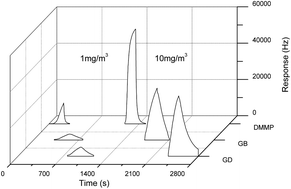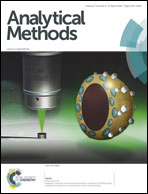The response comparison of a hydrogen-bond acidic polymer to sarin, soman and dimethyl methyl phosphonate based on a surface acoustic wave sensor
Abstract
A hydrogen-bond acidic (HBA) polymer, poly{methyl[3-(2-hydroxyl, 4,6-bistrifluoromethyl)phenyl]propylsiloxane}(DKAP), was coated on a 434 MHz surface acoustic wave (SAW) device, and subsequently tested against sarin (GB) and soman (GD) vapour along with dimethyl methyl phosphonate (DMMP) at concentrations below 10 mg m−3. The direct detection of GB and GD in the sub mg m−3 range, indicated the high sensitivity of the sensor, and was demonstrated by the corresponding sensor which showed high reproducibility as well. However, the response of the sensor to the real agents was relatively smaller and slower than to the simulant DMMP. Towards the real agents, the time to reach an adsorption equilibrium was considerable (∼16 min) and a time-dependent linear response was observed in the initial >3 min for both the adsorption and the desorption processes. The sensor was also compared with other HBA polymers coated SAW sensors in terms of response characteristics, with emphasis on the kinetic response behaviour. The slow adsorption and desorption property of the DKAP sensor towards the real chemical agents was attributed to the effect of the size of the analytes and to the strength of hydrogen-bonding, respectively.


 Please wait while we load your content...
Please wait while we load your content...